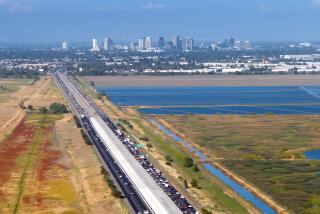Safety Comes to Those Who Wait on Loma Vista Road
- Share via
Dear Street Smart:
As a follower of Street Smart, I take issue with some of the comments made by Ventura traffic engineer Nazir Lalani.
I’ve repeatedly read Lalani whining about drivers who just don’t understand that the city’s traffic lights operate on a 110-second cycle and that signal changes on demand would create major traffic backups on intersecting streets.
But Lalani doesn’t understand the frustration of hundreds of motorists on Loma Vista Road who cannot readily cross Victoria Avenue.
I understand the concept that Victoria is a major arterial road. But by the time Victoria meets with Loma Vista, its traffic flow is reduced to a trickle. And most mornings, dozens of motorists are lined up on Loma Vista waiting for the signal to change, while there is little traffic on Victoria.
To make matters worse, during off-peak hours, drivers on Loma Vista wait up to 220 seconds for a green light. That’s nearly four minutes of waiting with no traffic in sight.
I know that Mr. Lalani probably won’t do anything about it because he’s got his rules.
But his rules don’t always work.
Someday those rules are going to cause a major traffic accident on that corner--rarely does a day go by when I don’t see one of my frustrated neighbors run the light.
Brenda Earner, Ventura
Dear Reader:
The rules that govern Loma Vista and Victoria were made in large part in response to demands of concerned residents, Lalani says.
Although you are concerned that the length of the red light at Loma Vista and Victoria could lead to an accident, the longer timing was installed as a result of an accident, Lalani says.
Until about two years ago, the signal was set on a 55-second cycle. Then a bloody accident led to demands from residents that the city improve the intersection.
The city installed a left turn arrow to increase safety, and doing so required a longer signal cycle.
Regarding the 220-second cycle during off-peak hours, Lalani says the light may not be detecting waiting traffic. The city will install more underground detectors to remedy the problem, he says.
*
Dear Street Smart:
Recently I have encountered the same unsafe situation at two Oxnard intersections.
Oxnard Boulevard at Gonzales Road has two left turn lanes in each direction.
But there does not appear to be enough room in the intersection for four cars to turn left at once, even if the two outside cars are small.
It gets extremely exciting when a large truck or other vehicle is involved.
The same situation exists at the intersection of Oxnard Boulevard and 5th Street.
I will no longer drive in the outside lane when turning left at these intersections because of the questionable safety of doing so.
Jane Hogle, Silver Strand Beach
Dear Reader:
It may seem like a tight squeeze, but rest assured there is sufficient room to turn left, Caltrans traffic engineer Luu Nguyen says.
The reason double left turn lanes exist at the two intersections is that the volume of traffic is very high, Nguyen says.
On an average day, 42,500 vehicle pass through Oxnard Boulevard and Gonzales. An average of 32,000 cross Oxnard Boulevard at 5th Street.
“It may seem scary, but it would be a lot worse to have all that traffic backed up all the time,” Nguyen says. “As long as people drive carefully, it is safe to turn left at these intersections.”
*
Dear Street Smart:
The street sensors do not appear to be working at the intersection of Madera Road and Bonita Drive in Simi Valley.
Every time I approach this intersection, the light turns red on Madera, even if no one is waiting at Bonita.
This signal interrupts a smooth flow of traffic, and it is quite annoying to have to wait in rush hour traffic for a light that is red for no apparent reason.
Daryl DeCrow, Thousand Oaks
Dear Reader:
The source of the problem you describe is a mystery, and Simi Valley traffic engineer Bill Golubics is determined to solve it.
The signal on Madera, which is supposed to turn red only when a car is waiting on Bonita, began malfunctioning after the Jan. 17 earthquake.
Golubics suspects that the quake caused the concrete to shift, stretching sensitive underground wires that trigger the signal.
As a result, the wires occasionally detect a phantom car on Bonita, and the light turns red although no car is actually present.
But Golubics’ diagnosis is still just a hunch.
Several residents have called the city to complain about the problem, but when city workers get out to the signal to fix it, they can’t find anything wrong.
“It’s the same as when you have a terrible noise in your engine, and then when you get to the mechanic, the car suddenly doesn’t make a sound,” Golubics says. “Quite frankly, it’s driving us nuts.”
If city workers are not able to pinpoint the source of the trouble, they may be forced to dig up the entire underground workings of the signal, which would cost thousands of dollars.
“We’re still hoping to figure this out and avoid the expense,” Golubics says. “But if we don’t resolve this soon, we may be forced to do that.”
More to Read
Sign up for Essential California
The most important California stories and recommendations in your inbox every morning.
You may occasionally receive promotional content from the Los Angeles Times.










